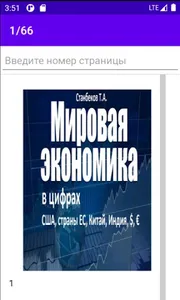A feature of the textbook is the formation of a practical understanding of the world economy through economic indicators (gross domestic product per capita, economic structure, exports, imports, etc.).
The content of the course reflects the main sections of the world economy: the structure of the world economy; major world currencies; international financial organizations; international economic unions; international trade; the developed countries; developing countries; international migration.
The classification of countries into developed and developing countries is presented. The criterion for their determination.
The value of stock indices Dow Jones, S&P 500, DAX 30, Nikkei 225, FTSE 100 and methods of their calculation are considered. The world's leading stock exchanges are represented.
The main currencies of the world are offered for study. The reason for the world recognition of the US dollar and the euro currency is revealed. The mechanism for calculating the cross-rate of currencies is shown.
The role of international financial organizations in the world economy is considered. Aims and functions of the International Monetary Fund, World Bank, European Bank for Reconstruction and Development, Islamic Bank. Criticism of their activities is presented.
International economic unions are offered for study. OECD, European Union, NAFTA, MERCOSUR, ASEAN. The benefits of countries from integration are shown.
There are represented commodity groups of export, import, large importers of the countries of the European Union.
The role of the World Trade Organization in the world economy is considered. Theoretical aspects of the balance of payments. The material on the reasons for the trade war between the United States and China is presented. Trade turnover, export, import of the USA.
The analysis of statistics of a group of developed countries, the structure of their economies is carried out. In particular, the US economy. The role of the Federal Reserve System, functions are considered. US balance of payments presented (digital material). US trade balance (exports, imports).
The characteristics of developing countries are given. The indicators of the economy of the PRC are considered. Economy of India. Their balance of payments, trade balance, GDP, GDP per capita, growth rate are presented. Development prospects.
The reasons and main countries with the largest influx of international migration are considered. The economic benefits of the receiving and sending sides of international migration are noted.
The total number of migrants in the world, the share of international migration with higher education, secondary and primary education are disclosed.
Explained the reason for the "brain drain" in the format of developed countries.
Conclusions are presented for each chapter.
The educational material is intended for students, young professionals, economists, managers, marketers, logisticians, entrepreneurs, everyone who wants to have an idea of the world economy and travel abroad.
The content of the course reflects the main sections of the world economy: the structure of the world economy; major world currencies; international financial organizations; international economic unions; international trade; the developed countries; developing countries; international migration.
The classification of countries into developed and developing countries is presented. The criterion for their determination.
The value of stock indices Dow Jones, S&P 500, DAX 30, Nikkei 225, FTSE 100 and methods of their calculation are considered. The world's leading stock exchanges are represented.
The main currencies of the world are offered for study. The reason for the world recognition of the US dollar and the euro currency is revealed. The mechanism for calculating the cross-rate of currencies is shown.
The role of international financial organizations in the world economy is considered. Aims and functions of the International Monetary Fund, World Bank, European Bank for Reconstruction and Development, Islamic Bank. Criticism of their activities is presented.
International economic unions are offered for study. OECD, European Union, NAFTA, MERCOSUR, ASEAN. The benefits of countries from integration are shown.
There are represented commodity groups of export, import, large importers of the countries of the European Union.
The role of the World Trade Organization in the world economy is considered. Theoretical aspects of the balance of payments. The material on the reasons for the trade war between the United States and China is presented. Trade turnover, export, import of the USA.
The analysis of statistics of a group of developed countries, the structure of their economies is carried out. In particular, the US economy. The role of the Federal Reserve System, functions are considered. US balance of payments presented (digital material). US trade balance (exports, imports).
The characteristics of developing countries are given. The indicators of the economy of the PRC are considered. Economy of India. Their balance of payments, trade balance, GDP, GDP per capita, growth rate are presented. Development prospects.
The reasons and main countries with the largest influx of international migration are considered. The economic benefits of the receiving and sending sides of international migration are noted.
The total number of migrants in the world, the share of international migration with higher education, secondary and primary education are disclosed.
Explained the reason for the "brain drain" in the format of developed countries.
Conclusions are presented for each chapter.
The educational material is intended for students, young professionals, economists, managers, marketers, logisticians, entrepreneurs, everyone who wants to have an idea of the world economy and travel abroad.
Show More

